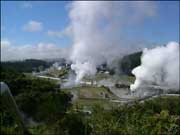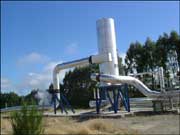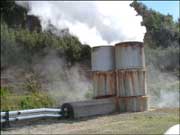6. Bore Field Equipment
Bores
Bores, (also called Wells) are the holes drilled into the
ground to remove hot water and steam.
At Wairakei the bores reach a depth of 2200m. The deepest bores do not
produce more steam. The best bores are those that meet a fault plane,
porous or fractured rock because here steam and water can flow easily.
The bores are not evenly spaced but are grouped above the best areas.
The Wairakei Borefield has three main areas:
- Eastern Borefield
This was the main steam area in the 1960's. However its pressure dropped and the temperature fell, due to the inflow of cool water. - Western Borefield
About 50% of Wairakei steam now comes from the Western Borefield. It has 30 wells drilled to a depth of 600m. - Te Mihi Borefield
About 50% of Wairakei steam now comes from the Te Mihi Borefield, It produces dry steam from a shallow (330-500m) and at high pressure (18-25 Bar). Below this is a large pool of hot water at a temperature of over 250°C.
Well heads
Well heads are the concrete walls and equipment used to
- hold valves and separators that control the flow of water and steam
- hold the drill rig while drilling or working down the well
The design of well heads has changed over time:
- Old well heads have a steam separators built into them. Modern well heads share a separator.
- Old well heads were dug out below ground level to help to hold it in place. This formed a 'cellar' below ground level. Modern well heads are level with the ground which helps to stop poisonous gases being trapped.
Steam Separators
Separators separate the dry steam and hot water.
Wairakei has mostly hot water at a temperature of 230-250 oC. When this water reaches the surface the pressure drops and the water suddenly boils. It becomes a mixture of 80% water and 20% steam. Only the steam can be used to drive the turbines so the water must be separated.
The way it is separated was invented by the first Wairakei engineers in the 1950's.
It works by:
- The steam and water mixture entering the separator at very quickly and at an angle.
- The water spins to the outside
- The lighter steam collects in the middle.
- The steam is then piped to the Power Station
- The water then flows to the Waikato River or passes to a Flash Plant.
Flash Plants
Flash plants produce extra steam from hot water. They do this by dropping the pressure rather than raising the temperature of the water. The Flashed steam is then be piped to the Power Station. Because the Flashed Steam is at a lower pressure it must travel in its own pipes.
Silencers
A silencer reduces the noise of steam escaping into the
air.
They are needed because the noise from the pressurised hot water escaping
to the air is so loud. Without a silencer even a small amount of steam
escaping could cause deafness, headaches, and dizziness in people working
nearby. With all 54 bores working, the noise from would be heard 10Km
away.
Within the Silencers there is also separation of steam and water, which produces big clouds of water vapour. These clouds are the most first thing that visitors notice.
Pipelines
The Pipelines at Wairakei carry both hot water and steam. They reach between Borefield, Power Station, Waikato River and the Reinjection wells.
| Main Steam Lines |
10 |
| Diameter | 300 -1200mm |
| Intermediate Pressure Steam | 1200 Tonnes per hour |
| Intermediate - Low Pressure Steam | 250 Tonnes per hour |
| Cladding | Aluminium |
| Insulation |
CaSiO3 or fibreglass Asbestos in older pipes |
| Pipe | Mild steel |
| Expansion - Contraction requirement | 5 - 10m over length. 1m per kilometre of pipe |
| Speed of steam in pipes |
About 100 kph or 30m/s |
| Travel time from bore to turbine | 2 -3 minutes |






